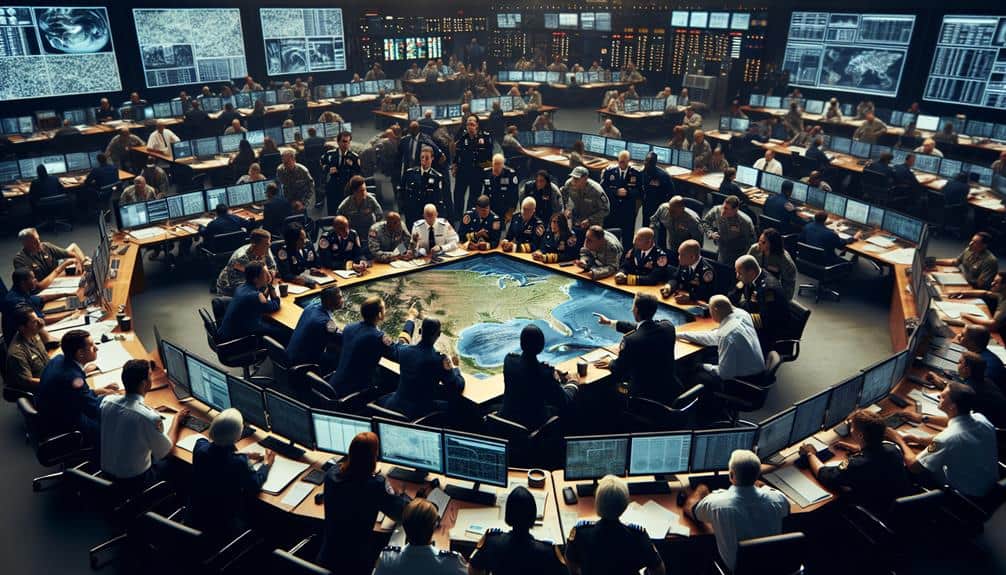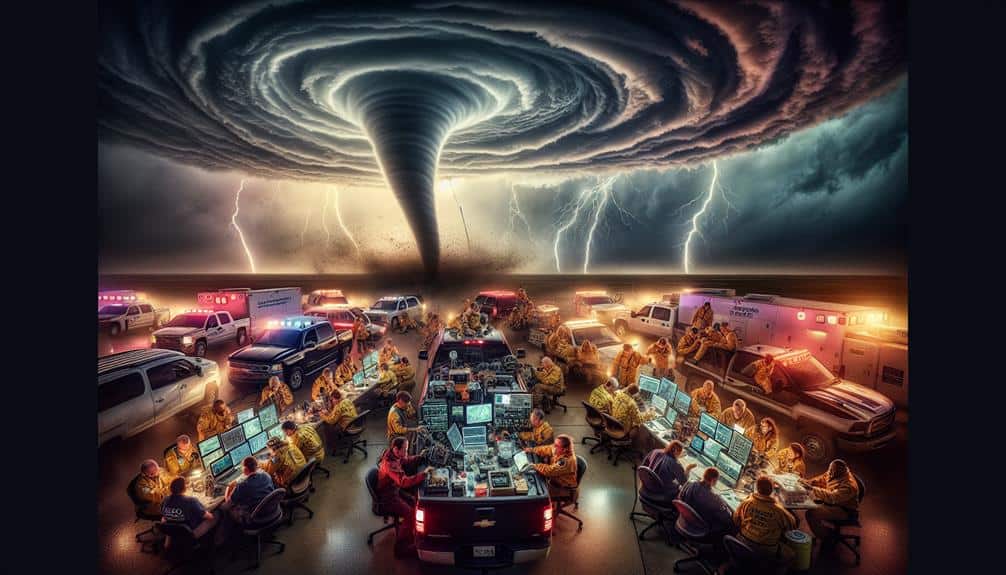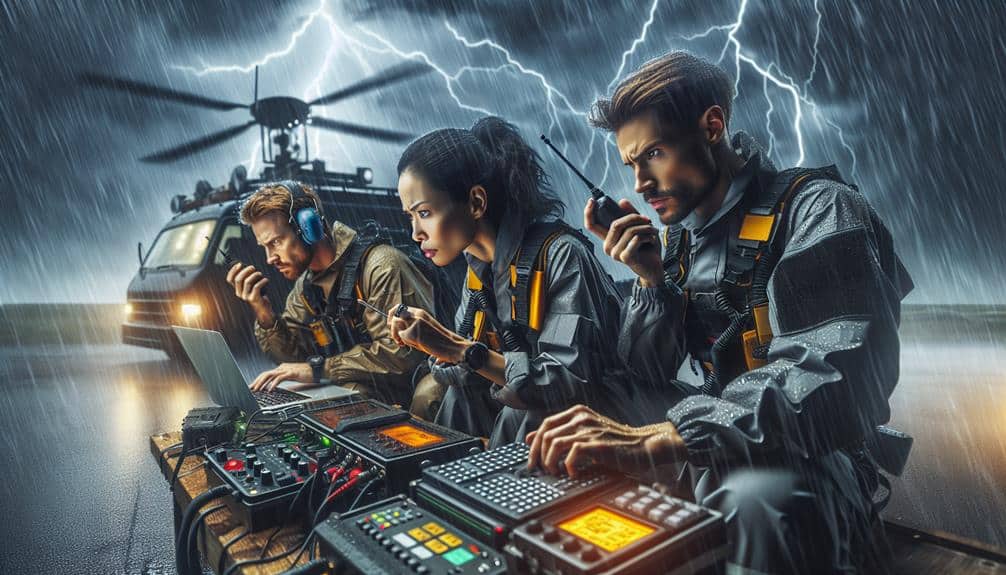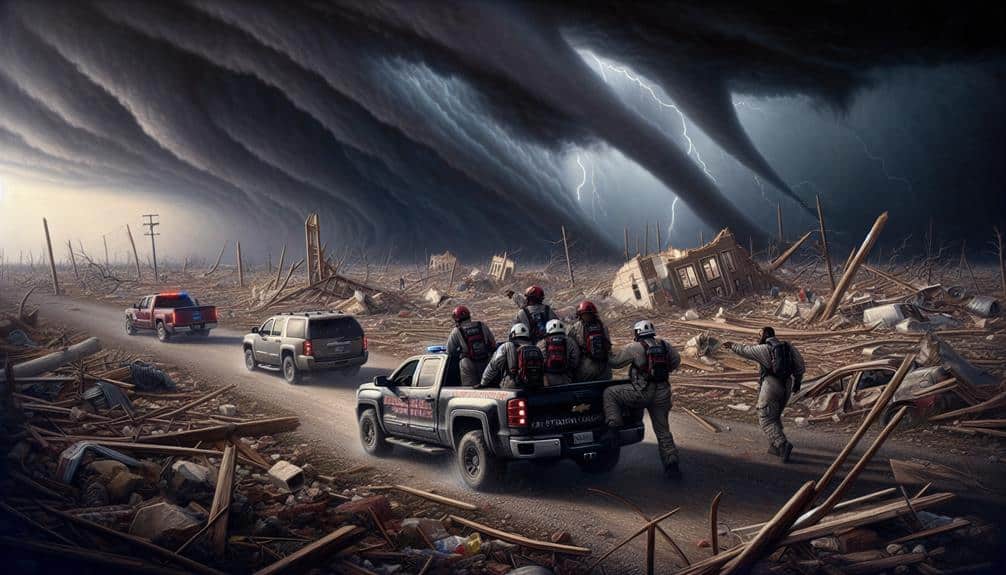To improve our emergency response communication, we must establish clear protocols and roles. Using dependable technology, like emergency alerts and mobile apps, is vital. Regular drills and realistic training scenarios help make procedures second nature. Standardized language guarantees everyone's on the same page, reducing misunderstandings. Interagency collaboration with unified systems promotes coordinated efforts. Real-time data sharing and live updates keep everyone informed, while backup communication systems guarantee we stay connected. These strategies can make our emergency responses more efficient and less chaotic. There's more to uncover if you're looking to master these indispensable techniques.
Key Points
- Establish clear roles and responsibilities to ensure effective emergency response.
- Utilize advanced communication technology like emergency alerts and mobile apps for instant updates.
- Conduct regular realistic training drills to enhance preparedness and response efficiency.
- Standardize communication terminology to eliminate confusion and streamline interactions.
Establish Clear Protocols
Establishing clear protocols is crucial to guaranteeing that everyone knows their roles and responsibilities during an emergency. When we set precise guidelines, we're not just ticking boxes; we're empowering our team to act decisively.
Training consistency is key here. Regular, standardized training sessions guarantee that everyone is on the same page, reducing confusion when it matters most. We can't afford to have team members unsure of their duties or the proper procedures.
Effective communication is another critical component. It's not enough to simply have protocols; we need to communicate them clearly and make sure they're understood. This means using straightforward language and providing opportunities for questions and feedback.
We should also practice these protocols regularly, reinforcing the training and making sure that they become second nature.
Utilize Reliable Technology
Leveraging dependable technology is crucial for ensuring smooth communication during emergencies. We must adopt advanced tools to keep everyone informed and coordinated. Emergency alerts and mobile apps can be lifesavers, providing real-time updates and critical information directly to our devices. These platforms guarantee that no one is left in the dark when quick action is needed.
Satellite communication offers a robust solution when traditional networks fail. In remote or disaster-stricken areas, satellites maintain our lines of communication, guaranteeing that emergency responders can relay information without interruption. Drones also play a pivotal role by providing aerial views of affected areas, helping us assess damage and allocate resources more efficiently.
We can't afford to rely on outdated or unreliable systems. By integrating these cutting-edge technologies, we enhance our ability to respond swiftly and effectively. It's about giving ourselves the freedom to act decisively, knowing we've the best tools at our disposal.
Embracing these innovations isn't just smart—it's essential for saving lives and minimizing chaos. Let's continue to push for technological advancements that empower us to handle emergencies with confidence and precision.
Conduct Regular Trainings
We need to conduct regular training sessions to guarantee our emergency response teams are always prepared and effective. Continuous practice keeps our skills sharp and our responses swift. Simulation exercises are vital; they mimic real-life scenarios, allowing us to rehearse our actions in a controlled environment. This way, when faced with actual emergencies, we act confidently and efficiently.
Regular training sessions also foster team building. When we work together in simulated conditions, we build trust and improve our communication. This seamless interaction is essential during actual crises, where every second counts.
Here are four key actions we should focus on:
- Schedule Frequent Drills: Regularly scheduled drills keep everyone on their toes and ensure that procedures are second nature.
- Incorporate Realistic Scenarios: Use detailed, realistic scenarios for simulation exercises to prepare for a variety of situations.
- Team Building Activities: Engage in team building exercises to strengthen trust and communication within the team.
- Evaluate and Adapt: After each training session, evaluate performance and adapt the training to address any weaknesses.
Develop Standard Terminology
Establishing a common language for our emergency response teams ensures clear and efficient communication during crises. When we develop standard terminology, we eliminate confusion and verify everyone's on the same page. The benefits of standardization can't be overstated; it enhances our ability to respond quickly and effectively.
Using consistent terminology means that when we say 'Code Red' or 'Evacuation,' everyone knows exactly what actions to take. We reduce misunderstandings, which could be critical in high-stress situations. By standardizing our language, we streamline communication across different teams and agencies, making coordination seamless. This consistency in terminology is essential for executing precise and timely decisions.
Let's face it, in an emergency, there's no room for ambiguity. We need to be confident that our messages are understood instantly. This confidence comes from knowing that we've all been trained to use the same terms in the same way. It's not just about jargon; it's about saving lives.
Foster Interagency Collaboration

We must strengthen interagency collaboration by implementing unified communication systems and conducting joint training exercises. These steps guarantee that all agencies can work seamlessly together during emergencies.
Unified Communication Systems
Implementing unified communication systems greatly enhances interagency collaboration during emergencies. By integrating various modes of communication, we guarantee seamless emergency coordination and mitigate the chaos that often arises in critical situations. Unified systems allow all agencies involved to communicate in real time, share crucial information, and make informed decisions quickly.
Here's how we can leverage unified communication systems:
- Interoperability: Guaranteeing that different communication tools and platforms can work together reduces delays and misunderstandings. This integration allows for a fluid exchange of information, essential for timely responses.
- Centralized Command: A unified system provides a single point of control, enabling better management and coordination of resources across all agencies involved. This centralized approach streamlines decision-making processes and enhances overall effectiveness.
- Real-Time Updates: With a unified system, all parties receive immediate updates, reducing the risk of misinformation. Real-time communication ensures that all responders are on the same page, fostering a coordinated effort.
- Scalability: These systems can be scaled to accommodate varying sizes and scopes of emergencies, guaranteeing that no situation is too big or too small to handle effectively.
Joint Training Exercises
How can we guarantee smooth interagency collaboration during emergencies? The answer lies in joint training exercises. These exercises are essential for fostering interdepartmental coordination and safeguarding that different agencies can work together efficiently when it matters most.
By engaging in realistic simulation scenarios, we can prepare for a range of emergency situations. These scenarios help identify potential gaps in our response plans and allow us to address them before a real crisis occurs. When we practice together, we build stronger relationships and trust between agencies, which is vital for effective communication during actual events.
Team building is another significant benefit of joint training exercises. When teams from various departments train together, they learn to understand each other's strengths and weaknesses. This mutual understanding enhances our overall emergency response capabilities and guarantees that everyone knows their role and responsibilities.
Emergency response training should be a regular part of our preparedness efforts. By making joint training exercises a priority, we can create a culture of collaboration and readiness. This proactive approach not only improves our ability to handle emergencies but also empowers our teams to act with confidence and autonomy when disaster strikes.
Implement Real-time Reporting
We need to prioritize real-time reporting to enhance our emergency response.
By sharing data instantly and providing live situation updates, we guarantee everyone has the information they need.
Immediate incident alerts will keep all teams informed and ready to act.
Instant Data Sharing
Real-time reporting allows emergency response teams to share critical data instantly, enhancing coordination and decision-making. With real-time monitoring and data encryption, our teams can guarantee that sensitive information is secure while maintaining the agility needed to respond effectively.
Here's how we can maximize the benefits of instant data sharing:
- Implement Real-time Dashboards: These provide a centralized view of all ongoing activities, enabling us to monitor situations as they unfold and make well-informed decisions quickly.
- Use Secure Communication Channels: Encrypting data ensures that only authorized personnel have access to critical information, safeguarding it from unauthorized access and potential cyber threats.
- Integrate Mobile and IoT Devices: Leveraging mobile devices and IoT sensors allows us to gather and share real-time data from the field, delivering thorough situational awareness to all team members.
- Automate Data Collection: Automated systems reduce the risk of human error and guarantee that data is captured accurately and promptly, freeing up our teams to focus on immediate response actions.
Live Situation Updates
To ensure timely decision-making and effective coordination, live situation updates provide real-time reporting directly to our emergency response teams.
When seconds matter, real-time communication is essential for maintaining situational awareness. By implementing live updates, we make sure that everyone involved has the most current information, allowing for swift, informed actions.
Real-time reporting tools enable us to track evolving situations, share critical data instantly, and adjust our strategies as events unfold. This dynamic flow of information enhances our ability to respond to emergencies, allocate resources efficiently, and prioritize tasks effectively. Essentially, live situation updates are the backbone of our emergency communication strategy.
We can't afford delays in high-stakes scenarios. With real-time communication, we're not waiting on outdated reports or second-hand information. Instead, our teams receive continuous, accurate updates that reflect the current state of affairs.
This immediate access to information empowers us to make proactive decisions, minimizing risks and maximizing our response effectiveness.
Immediate Incident Alerts
Immediate incident alerts guarantee our teams are instantly notified of any developing emergencies, enabling a rapid and coordinated response. With real-time notifications, we eliminate delays and make certain that everyone is on the same page. This means we're not just reacting; we're proactively managing the situation as it unfolds.
Here's how we can implement effective real-time reporting:
- Automated Emergency Alerts: Setting up automated alerts secures that the right people are notified immediately, reducing human error and response time.
- Multi-Channel Notifications: Use multiple communication channels—SMS, email, push notifications—to reach team members regardless of their location or device.
- Integration with Existing Systems: Make sure our alert system integrates seamlessly with current emergency management systems to streamline operations.
- Priority-Based Alerts: Differentiate alerts based on urgency and type of incident, so that critical situations get prioritized attention.
Ensure Redundant Systems

Why is it important that we establish backup systems to guarantee uninterrupted communication during emergencies? When disaster strikes, our primary communication channels might fail, leaving us vulnerable. That's why we need backup plans and communication redundancy to make sure we stay connected no matter what.
This isn't just about having a second option; it's about having multiple layers of communication systems ready to go. We should integrate various methods such as satellite phones, radios, and internet-based communication tools. Each type of technology comes with its own strengths and weaknesses, but together, they create a robust network.
If one system fails, another can seamlessly take over, ensuring we can still coordinate our efforts and keep everyone informed. Regularly testing these redundant systems is essential. We can't afford to discover a malfunction in the middle of a crisis. By routinely checking and updating our backup plans, we guarantee that our communication channels remain reliable.
In the end, having redundant systems isn't just a precaution; it's a necessity. It empowers us to act swiftly and effectively, making sure our teams can operate freely and confidently, even in the most challenging situations. Let's prioritize communication redundancy to safeguard our mission and our people.
Frequently Asked Questions
How Can We Ensure the Privacy of Sensitive Information During Emergency Responses?
We wouldn't want our secrets spilled, right? Let's use encryption measures and secure communication channels to guarantee sensitive information stays private during emergency responses. Freedom isn't free; it needs security to thrive.
What Steps Should Be Taken to Manage Stress Among Emergency Responders?
To manage stress among emergency responders, we should prioritize stress management and team support. Implementing mental health check-ins and resilience training helps maintain our well-being and guarantees we're prepared to handle high-pressure situations effectively.
How Can We Improve the Coordination Between On-Site and Remote Emergency Teams?
We can boost coordination between on-site and remote teams by enhancing remote communication tools, fostering real-time collaboration, and integrating on-site response protocols. This approach guarantees seamless operations and empowers responders to act swiftly and effectively.
What Are the Best Practices for Post-Incident Analysis and Feedback?
We should conduct thorough incident debriefings, implement a structured feedback process, and use performance evaluations to identify strengths and weaknesses. This approach promotes continuous improvement and guarantees we're always ready for future emergencies.
How Can We Involve the Community in Emergency Preparedness and Response Efforts?
We can revolutionize our emergency preparedness by involving the community through dynamic engagement and outreach initiatives. Let's empower everyone with the knowledge and tools needed for resilient response efforts, ensuring we're all prepared and united.


